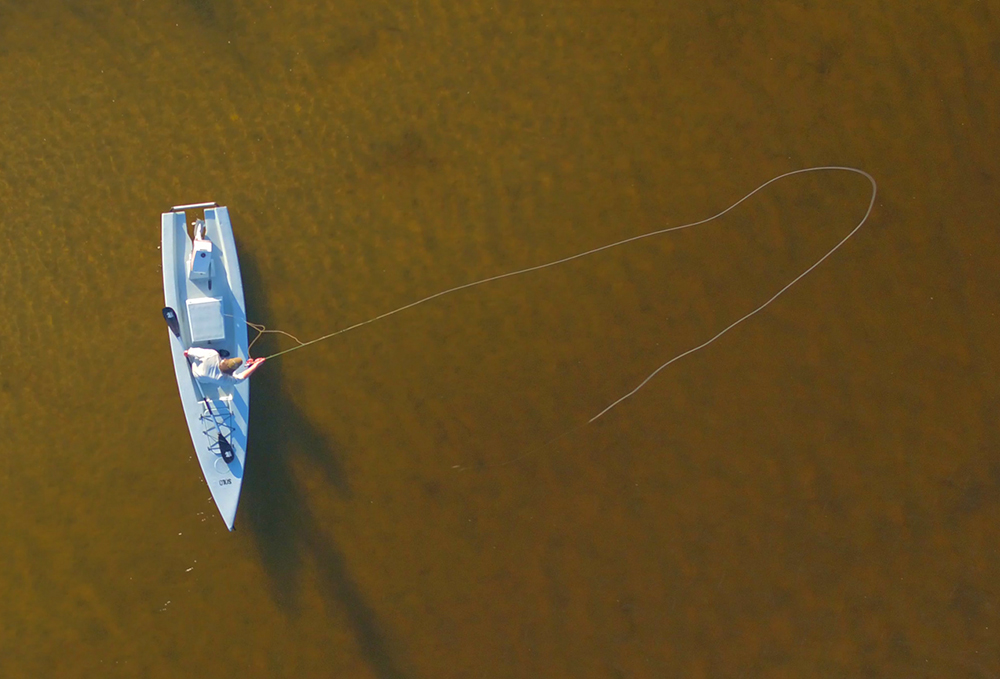When I started fly fishing I fished from a wooden canoe I built which was actually the first boat I had built. I caught a lot of fish in that boat and quickly learned a lot about fly fishing from small craft . I then built a fly fishing kayak as I called it. It was a recreational rowing shell I had found and I turned it into a cross between a sit on top and a cockpit style kayak. My fly fishing kayak had a rod tube, GPS, storage, it was cool. That kayak saw a lot of fly rod caught redfish believe me. These two prior craft of mine taught me a lot about what was needed to fly fish from a kayak. These craft also started a lot of the ideas that led to Solo Skiff. Fly fishing alone, no matter the craft is a challenge, and one I love. Nothing is more satisfying than stalking a fish alone, and presenting a fly (especially if you tie your own) and catching a fish. Now the biggest part of the challenge is managing the boat, as long as you can cast efficiently. You should be able to easily cast with ONE backcast 50 feet, or start practicing my friend !
We hear the word ‘multitasking’ a lot now- well let me tell you something thats what fly casting in a small craft is all about my friends ! Trying to paddle forward, set the paddle down, stop the boat from moving if you wanted, and picking up the rod to cast is a lot going on,its true multitasking haha. It gets busy as you see. Anything we can do to lessen this ‘load’ is good as it makes concentrating on the cast a lot easier. This is where a Solo Skiff is a really nice tool, I’ll explain. Getting in range to the fish while standing can be easy, but doing the rest is where it starts to be a challenge. There are a couple ways to do it. You can pole into position and stake off with the pole, or, paddle into position, and anchor or drift. Both methods produce fish but I have learned, the solo makes it easier.. and if you paddle into position its a piece of cake. Poling into position is good as well, however there is a higher learning curve due to the fact you have to manage the pole, and keep quiet, and handle your rod / line… The pole like a paddle propels the watercraft through the shallows, but a pole allows you to stop on a dime, anchor the boat and its easy to do on a soft bottom, but…after much trial and error, it is easier to multitask with the paddle….so its easier to cast the fly rod. Now a lot of guys have no problem sitting and casting, nor do I but we ALL know its easier to stand and cast a fly rod for sure and why I like fly fishing from my Solo Skiff. The fact your standing with a pole makes it easier to judge distance I think and figure out what step to do next as far as approaching the fish and stopping to pickup your rod and cast, now the pole can be used for this or you can position a wang (wanganchor.com) anchor to use to stop the boat. Practice makes perfect for sure and I tell people all the time to be patient while learning to do this, as it is the key to fly fishing from a small craft. A lot of fly fishing from a kayak shaped how I fish from a Solo Skiff. Another point Ill make is cockpit design. Having the cockpit open and flat is important. You need and area to EASILY stand, AND strip your line. You don’t want to be stripping line and have it going into the water… not a good thing. The Solo Skiffs cockpit also makes it easy to lay the rod down quietly without it falling out or banging around while approaching fish…a nice feature and one more thing to ease the challenge a bit. Fly rod management can be a factor in fly fishing. Keep the line you have stripped out to a minimum ! You should strip about 25 feet max and have it coiled on the cockpit floor very neatly under the rod. The reel can be between the raised platform and gunnel with rod pointing forward to keep it away from where you pole. Then when your ready to cast it’s a very simple matter to stop the boat with your pole, put the pole under your left arm, pick up the rod and roll cast the line out, backcast… and deliver the fly… with practice you will find its not that hard. But add a lil wind, current, fast moving fish… and it gets real fun !
Now sitting and paddling your solo into position is definitely easier. Gently approach the fish and put your paddle down in the cockpit however is comfortable and out of the way of your line, and make your cast. The thick hull of the Solo Skiff helps by making all this dead quiet as its a sound deadening hull like no other small fishing boat or kayak.
